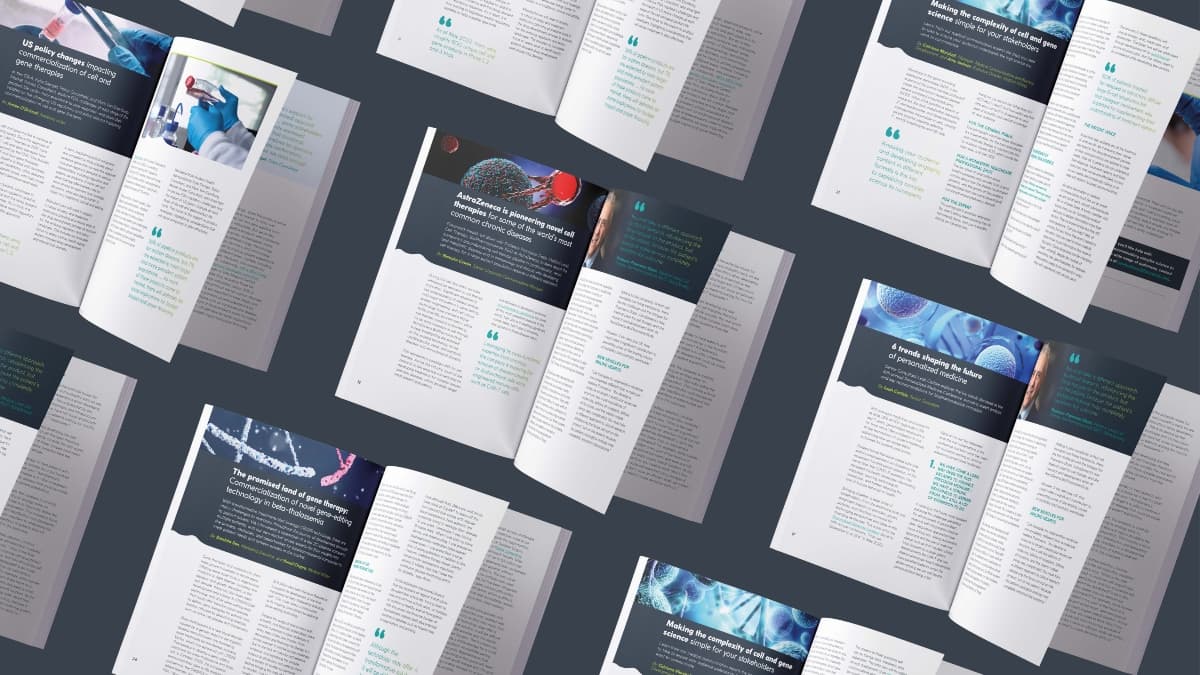
US policy and regulatory changes impacting commercialization of cell and gene therapies
Key takeaways:
- The cell and gene market still faces a lack of cohesion across stakeholders when it comes to classification of products
- Expertise is in disparate pockets across the FDA, making it challenging to plan review teams
- Regulators and policymakers are placing greater emphasis on accurate and diverse representation in trial populations
- Tailoring an effective evidence-generation plan at the clinical phase is vital for ensuring ongoing evidence generation remains informative into product life cycle
This is an extract from Fishawack Health’s new publication on the cell and gene therapy landscape. Download it here.
The cell and gene market is evolving at lightning speed. Since the approval of the first CAR-T therapy in 2017, more than 20 cell and gene therapies have been approved by the FDA. This includes six CAR-T and four gene therapies.1 Today, the pipeline is filled with hundreds of these novel candidates, often designed to treat therapeutic areas with high unmet need and limited alternative treatments. This has led to a dynamic landscape in which the FDA has struggled to upskill in the complex science and the rising demand for regulatory expertise. As a result, it is now turning to legislative and/or regulatory updates to help expedite approvals.
In turn, biopharmaceutical companies are compelled to think critically about evidence generation to meet the approval and post-approval demands of various stakeholders, including regulators and payers, as evidence of novel cell and gene therapy effectiveness may be more pivotal to approval and coverage decisions, while also being harder to obtain in a traditional clinical trial setting.
Manufacturers will need to employ a robust strategy and implement meticulous planning procedures early in the drug development process to account for the evolving regulatory and policy landscape. This includes an increased focus on areas such as health equity, patient-focused drug development, and clinical trial diversity.
Avalere Health, which joined Fishawack Health in June 2022, is a leading healthcare consulting firm based in Washington, DC. Avalere’s team of more than 200 advisors offers vast experience and expertise in federal policy and policy developments across all 50 states.
Kylie Stengel, Policy Consultant, and Mark Von Eisenburg, Market Access Consultant, shed light on the key FDA regulatory challenges and the impact of US policy changes for product developers, highlighting considerations that will equip companies to plan effectively.
FH: There are a significant number of cell and gene therapies in the pipeline, raising some questions around the FDA’s ability to keep up with application reviews. Can you tell us about some of the FDA regulatory challenges?
Mark: In the preclinical phase, one of the core issues the cell and gene market still faces is lack of cohesion across stakeholders when it comes to classification of products. We’re operating with emerging biotechnology in which combinations of novel technologies and complex manufacturing processes might be intermingled between a gene therapy and a cell therapy or aspects of both.
Another challenge is that we don’t want the novelty of technology to force riskier or inefficient policies or regulatory processes. However, from what we see now, the technology will outpace some of the regulatory precedents, which aligns with the historically reactionary manner in which review expertise is gained for novel technologies.
Similarly, in the preclinical phase, you need to think about where the expertise might lie at the FDA. This is an important consideration because we think about cell and gene therapies being regulated by the Center for Biologics Evaluation and Research. But there are instances, for example, with RNA therapeutics, where biologics are regulated by the Center for Drug Evaluation and Research, because that’s where the FDA expertise is, so planning review teams is an additional challenge. We see the FDA working on its current thinking regarding CAR-T–specific cell therapy, as well as gene therapy–specific manufacturing guidance. Although these publications might provide areas of clarity for product sponsors, there’s still a need for best practices when it comes to this early stage of development.
FH: On the legislative front, do we see any movement as it intersects with preclinical or early-stage regulatory challenges?
Kylie: The House draft User Fee Amendment or UFA reauthorization bill released in May 2022 would have required the FDA to convene a public workshop on the best practices for generating scientific data to facilitate the development of human tissue and cellular-based products. Additionally, the draft Cures 2.0 legislation would require the FDA to submit a report to Congress on the FDA’s challenges related to cell and gene products in the next 10 years and what’s needed to address those challenges. This bill is still proposed in the US House of Representatives and has yet to be considered. However, now that the User Fee program has been advanced into law (on September 30) without additional policy riders being included, some provisions specific to cell and gene therapies will become law before their impact is felt.
FH: Now that we’ve discussed the preclinical phase, can you highlight some of the core challenges in the clinical phase?
Mark: The first that comes to mind has to do with this topic of patient-focused drug development. This relates to a push we’ve seen recently—fueled by some learnings from the COVID-19 pandemic—for getting accurate representation in your trial population. The challenge of generating powered data for a small patient population is a key issue for many cell and gene therapies that are under development. We need to see innovative methods for continuous monitoring of patients for use of real-world data and standardizing this into real-world evidence to assist on both the pre- and post-market sides of evidence generation.
Additionally in the clinical phase, we think about the concept of FDA-expedited development and approval pathways. There are quite a few of these and they are particularly relevant to cell and gene therapies, which often treat diseases that have high unmet medical needs or are serious and life-threatening.
Tailoring an effective evidence-generation plan at the clinical phase so that your ongoing evidence generation remains informative into the product life cycle is a challenge that cell and gene therapy manufacturers might face at a higher rate than other manufacturers.

Get the full analysis
This is an extract from Fishawack Health’s new publication on the cell and gene therapy landscape.
Download the report to access the full article providing further analysis of the review stage, patient-focused drug development, and expedited pathways.
In the publication, you will also gain insights on:
- AstraZeneca’s innovation in cell therapy for chronic diseases
- Gene editing to treat blood disorders
- Trends shaping the future of personalized medicine
- Communicating complex science to nonexpert stakeholders
About the Authors
Kylie Stengel, Policy Consultant
Kylie is a policy consultant who focuses on regulatory and legislative developments, with specific expertise in Medicare Part D payment and policy, drug pricing reforms, and health insurance markets. She supports clients spanning a range of healthcare sectors and stakeholders in assessing the impacts of the evolving policy landscape on their business and advocacy priorities.
Mark Von Eisenburg, Market Access Consultant
As a specialist in market access, Mark couples his training in age-related diseases, specifically Alzheimer’s disease, with a background in effective scientific communication to help clients understand translational research and science policy and to deliver digestible insights that inform market access strategies.
About Fishawack Health
Established in 2001, Fishawack Health (FH) is a purposefully built commercialization partner for the biopharmaceutical, medical technology, and wellness industries. Our 1,500+ experts combine their knowledge and expertise across our core disciplines—Medical; Marketing; Policy; Value, Evidence, and Access; and Consulting—to create the connections that make better health happen.
We partner with our clients to navigate the complex and rapidly changing healthcare ecosystem. Together, we realize the potential of strategies and solutions to bring innovation to the hands of those who can benefit from it.